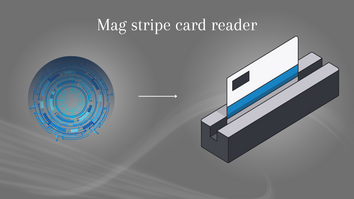Magnetic stripe (or “mag stripe”) card readers have been a staple in access control, payment processing, and identity verification for decades. Whether you’re swiping a credit card, checking into a hotel, or using an employee badge, chances are you’ve interacted with this technology. But what’s actually happening when that stripe slides through a reader? Let’s take a closer look.
The Science Behind the Magnetic Stripe
A mag stripe card has a thin band of magnetic material embedded on its surface. This stripe is made up of countless tiny magnetic particles, which can be arranged in patterns to represent stored information.
Most cards use three distinct tracks on the stripe:
- Track 1 – Stores alphanumeric data, commonly used in financial transactions.
- Track 2 – Stores numeric-only data, frequently used for banking and security systems.
- Track 3 – Less commonly used, but capable of storing extra security details.
These tracks are encoded using a process called magnetic encoding, where the particles are aligned in specific ways to create a digital “signature” unique to that card.
How a Mag Stripe Reader Works
The process of reading a mag stripe card is simple but clever:
- Swiping or Inserting the Card – When a user passes the card through a reader, the magnetic stripe moves across a small component called the read head.
- Detecting Magnetic Data – As the stripe moves, the read head senses variations in the magnetic field. These tiny changes represent the encoded information.
- Signal Conversion – The reader translates the magnetic data into an electrical signal, which is then converted into usable digital information.
- Verification – The system connected to the reader (such as a payment terminal, access control server, or computer) checks this data against its database. If it matches a valid record, access is granted, a transaction is approved, or the identity is confirmed.
Where Mag Stripe Readers Are Used
Despite the growth of chip cards and mobile credentials, mag stripe technology is still widely used in everyday applications, including:
- Payment Processing – Credit and debit cards for fast checkout.
- Access Control – Entry systems for offices, hotels, and restricted areas.
- Public Transportation – Fare cards in some transit systems.
- Identification – Student IDs, membership cards, and employee badges.
Thanks to card printers like the Evolis Printer, organizations can easily create customized mag stripe cards for these purposes.
Strengths and Limitations of Mag Stripe Technology
Mag stripe card readers remain popular because they are affordable, simple, and widely compatible. However, they aren’t without challenges:
- Durability Issues – Stripes wear down with frequent use, leading to misreads.
- Security Risks – Data can be skimmed by counterfeit devices, making cards vulnerable to duplication.
- Limited Capacity – Mag stripes hold less data than modern alternatives like smart cards or RFID.
For these reasons, many organizations are shifting toward more secure solutions such as EMV chip cards, NFC credentials, and mobile access systems.
Should You Still Use Mag Stripe Cards?
While newer technologies offer stronger security and greater flexibility, mag stripe readers remain a cost-effective solution in many industries. For businesses and organizations looking for a simple, proven method of access and authentication, they continue to get the job done.
Unlock Your Options with EvolisPrinter.com
Mag stripe card readers may be aging technology, but they still play a crucial role in access control and identity management. Whether you need Evolis Printer solutions to create custom mag stripe cards or are considering an upgrade to more advanced access systems, EvolisPrinter.com can help you choose the right path forward.
Contact us today to learn more about mag stripe card systems and explore modern alternatives that fit your security needs.

